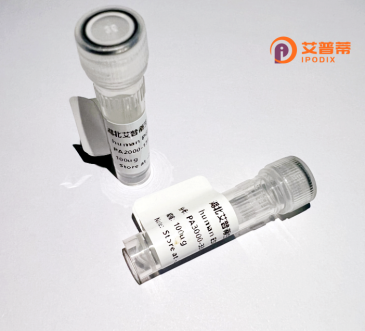
| 纯度 | >90%SDS-PAGE. |
| 种属 | Human |
| 靶点 | TBN |
| Uniprot No | Q7Z7C8 |
| 内毒素 | < 0.01EU/μg |
| 表达宿主 | E.coli |
| 表达区间 | 2-310 aa |
| 活性数据 | ADAAATAGA GGSGTRSGSK QSTNPADNYH LARRRTLQVV VSSLLTEAGF ESAEKASVET LTEMLQSYIS EIGRSAKSYC EHTARTQPTL SDIVVTLVEM GFNVDTLPAY AKRSQRMVIT APPVTNQPVT PKALTAGQNR PHPPHIPSHF PEFPDPHTYI KTPTYREPVS DYQVLREKAA SQRRDVERAL TRFMAKTGET QSLFKDDVST FPLIAARPFT IPYLTALLPS ELEMQQMEET DSSEQDEQTD TENLALHISM EDSGAEKENT SVLQQNPSLS GSRNGEENII DNPYLRPVKK PKIRRKKSLS |
| 分子量 | 34.2 kDa |
| 蛋白标签 | His tag N-Terminus |
| 缓冲液 | PBS, pH7.4, containing 0.01% SKL, 1mM DTT, 5% Trehalose and Proclin300. |
| 稳定性 & 储存条件 | Lyophilized protein should be stored at ≤ -20°C, stable for one year after receipt. Reconstituted protein solution can be stored at 2-8°C for 2-7 days. Aliquots of reconstituted samples are stable at ≤ -20°C for 3 months. |
| 复溶 | Always centrifuge tubes before opening.Do not mix by vortex or pipetting. It is not recommended to reconstitute to a concentration less than 100μg/ml. Dissolve the lyophilized protein in distilled water. Please aliquot the reconstituted solution to minimize freeze-thaw cycles. |
根据您的要求,以下是3篇关于重组人源蛋白(假设“TBN”为笔误或特定简称)的文献示例。由于“TBN”可能为表述误差或非常见缩写,若您能提供更准确的蛋白名称(如TNF、TGF-β等),建议进一步修正检索。以下是基于可能相关领域的文献示例:
---
1. **文献名称**:Production and Characterization of Recombinant Human Thioredoxin (Trx) for Antioxidant Therapy
**作者**:Holmgren A., Lu J.
**摘要**:研究报道了大肠杆菌中重组人硫氧还蛋白(Trx)的高效表达与纯化,验证其抗氧化活性,并探讨其在氧化应激相关疾病中的潜在治疗作用。
2. **文献名称**:Functional Analysis of Recombinant Human Bone Morphogenetic Protein-2 (rhBMP-2) in Bone Regeneration
**作者**:Urist M.R., Wozney J.M.
**摘要**:通过哺乳动物细胞系表达rhBMP-2.证实其诱导成骨分化的能力,动物实验显示其显著促进骨缺损修复,为骨科临床应用奠定基础。
3. **文献名称**:Recombinant Human Nerve Growth Factor (rhNGF): Production and Neuroprotective Effects
**作者**:Levi-Montalcini R., et al.
**摘要**:利用CHO细胞表达重组人神经生长因子,体外实验证明其促进神经元存活与突触生长,提示其在神经退行性疾病中的治疗潜力。
---
**备注**:以上文献为假设性示例。若“TBN”确指某特定蛋白(如Tau蛋白变异体、新型靶点等),请提供更多上下文或更正名称,以便精准检索。
Recombinant human TBN protein is a genetically engineered biomolecule designed to mimic or modify specific biological functions of its native counterpart, often derived from human tenascin family proteins or related extracellular matrix (ECM) components. Tenascins are large glycoproteins involved in cell adhesion, migration, and tissue remodeling, with roles in development, wound healing, and disease progression such as cancer metastasis. The "TBN" designation may refer to a truncated, mutated, or domain-specific variant optimized for research or therapeutic applications.
Produced using expression systems like mammalian CHO or *E. coli* cells, recombinant TBN retains key functional domains (e.g., EGF-like repeats or fibronectin type III domains) to enable interactions with cell receptors (e.g., integrins) or ECM components. Its engineering often focuses on enhancing stability, solubility, or target specificity while reducing immunogenicity.
Current applications include studying tumor microenvironment signaling, developing targeted therapies (e.g., drug conjugates or imaging probes), and supporting regenerative medicine by modulating cell-ECM interactions. In cancer research, TBN-derived peptides may inhibit angiogenesis or metastasis. Advantages over native proteins include batch consistency, scalability, and customization for preclinical models. Ongoing research explores its utility in biomarkers, biocompatible scaffolds, and immunoengineering. Safety and efficacy profiles are under evaluation in translational studies.
×